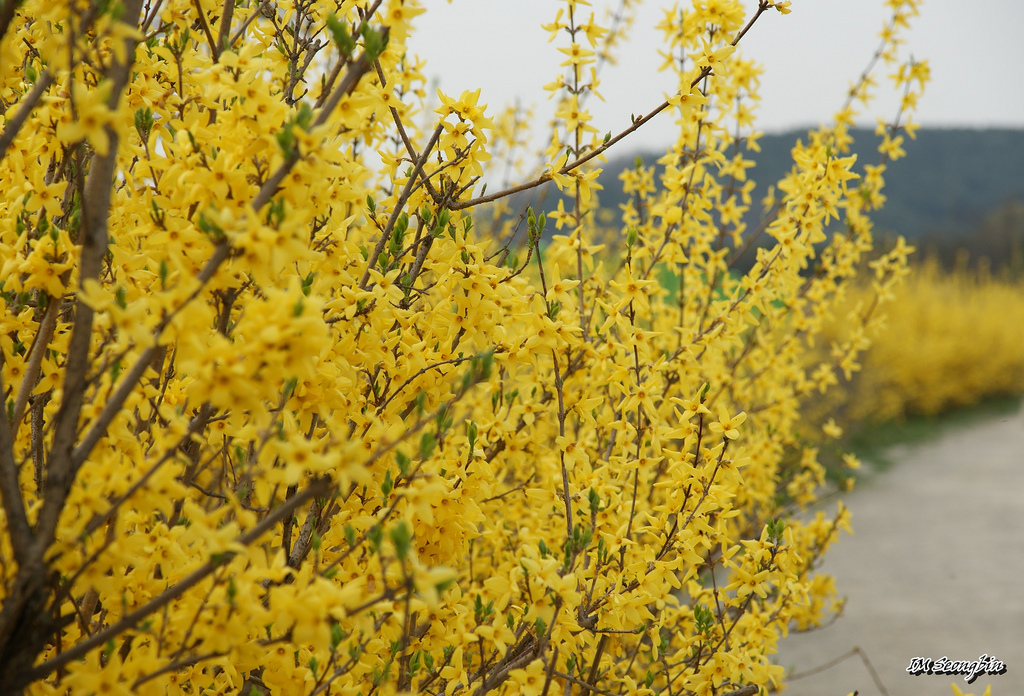Table of Contents:
 Photo by Seongbin Im
Photo by Seongbin Im
Once established, Forsythia, otherwise known as Golden Bell, are one of the easiest shrubs to grow. With nearly no maintenance at all they quickly grow several feet each year into beautiful bushes that announce the arrival of spring with their bright yellow flowers. Whether you’re looking for a single shrub or a hedgerow of color, these plants are sure to add a striking touch of gold to your landscape or garden.
Before You Plant
Choose the Right Type:
- Most forsythia shrubs are hardy in zones 4-9. Check the particular cultivar for temperature ranges as some do better in cold climates than others.
- There is a wide range of sizes from compact one-foot plants to taller varieties that can reach 8-10 feet. Some plants also grow just as wide as they do tall, be sure to find a variety that will fit well in your space.
- Check with your local nursery or greenhouse to locate a variety that will thrive in your area.
Find a Suitable Place:
- The bright blooms require an area with full sun or partial shade. Generally, the more sun the plant receives, the more vibrant the blooms will be.
- Taller varieties grow well next to buildings or other structures that may offer some support.
Prepare the Soil:
- Though these plants will grow in poor conditions, there are steps you can take to ensure the best growth.
- The soil should be well-draining, amend heavy soil with plenty of compost.
- Adding garden compost, peat moss or composted manure to the soil will supply the necessary nutrients to give your plant a great start!
Planting/Growing/Pruning
What You Will Need:
- Forsythia plants
- Small shovel
- Organic compost/mulch
- All purpose fertilizer (10-10-10)
- Prepared soil
- Water
Steps for Planting Forsythia:
- Start by digging a hole twice as wide as and slightly deeper than the current container holding the shrub.
- Remove the root ball from the container and place it into the hole, trying to keep it at the same depth as it was in the original container.
- Fill in with removed soil and pat to firm.
- Water thoroughly immediately after planting.
- Applying a layer of mulch around the plant will keep the ground moist and help keep weeds under control.
- Continue to water during dry spells and fertilize once or twice a year with a general fertilizer. If you’d like to enhance the blooms on your shrub, use a fertilizer high in phosphorous.
Steps for Pruning Forsythia:
- Though these plants are virtually maintenance free to grow, they will quickly get out of hand if they are not pruned regularly.
- These plants grow very quickly, so it’s okay to prune them aggressively.
- It is best to prune immediately after the flowers fade, before the buds for next year’s flowers develop.
- Cut back about ¼ of the old stems to 4 inches above the ground each year.
- If your plant becomes overgrown and stops blooming, cut the entire plant back to the ground. It will grow back within a few years and look better than ever!
Forcing Winter Blooms Indoors
- If you’d like a splash of color to brighten up those dreary winter days, you can bring some of your forsythia branches indoors and force them to bloom.
- Choose some branches from the top of the plant and cut them off close to the stem. The larger the buds, the better the blooms will be.
- Remove the buds and branches on the lower part of the stem (the part that will be submerged in water) to avoid rotting.
- Cut the stem at an angle and place into cold water. Set the vase with branches in a cool area for a couple of days.
- Cut the stem again at an angle and place in warm water. Set the vase and branches in a bright sunny area until they begin to bloom.
- Enjoy this splash of color on a dark winter day! As an added bonus, the cuttings may form roots which can be transplanted for new plants!
Propagation of New Plants
With Cuttings:
- New plants can easily be propagated with cuttings anytime as long as there is some new growth available.
- Cut 3-6 inches of new growth from the end of a branch.
- An optional step is to dip the end of the cutting into rooting hormone to expedite the production of roots.
- Place the end of the cutting into a glass of water or a small pot filled with fresh, moist soil.
- Keep the cutting in the rooting medium until roots begin to grow. This usually takes a couple of weeks.
- Rooted cuttings can be planted at anytime.
Additional Tips and Advice
- If the blooms on your plant are not vibrant, it may not be receiving enough sunlight.
- If transplanting established plants, it is best to do in winter when they are dormant.
- Pests and disease are not common problems, treat as necessary.
Related Posts
No related posts.